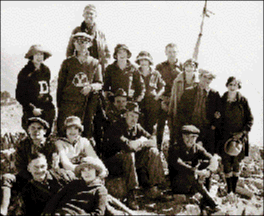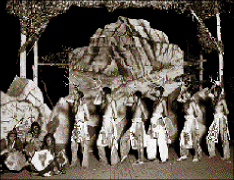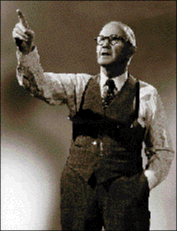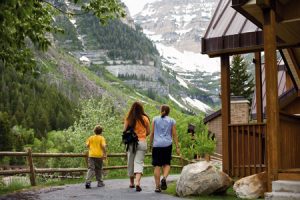The man and the mountain are after all much alike.
–Harry Davison Kemp
The event which perhaps most focused the spotlight on Brigham Young University during the middle decades of this century wasn’t conceived in Provo, or even in Utah, but somewhere near Einsiedeln, Switzerland, as 5,000 worshipers made their way to a hilltop shrine. In 1908 Eugene Lusk Roberts, an LDS missionary from Provo, watched those Swiss pilgrims and envisioned for his hometown a similar tradition–the Timpanogos Hike.
For Roberts, the annual hike to the summit of Utah County’s 11,750-foot “Wonder Mountain,” as he called it, always had religious underpinnings. Roberts’ purpose in starting the community climb, which brought thousands to the mountain from 1912 to 1971, was nothing less than helping others worship at the great outdoor shrine.
“Roberts felt the Lord reveals himself to man powerfully in nature and that a stern climb in utter beauty would be spiritually good for anyone,” wrote a Sports Illustrated correspondent in a 1957 article.
A pioneer of athletic education and a dynamic Renaissance man, Roberts did more than climb mountains. He coached two world-class high jumpers and laid the foundation for today’s athletic program at BYU. He mingled with early 20th-century luminaries such as boxing champ Jack Dempsey, actor Douglas Fairbanks, and football coach Knute Rockne. Roberts brawled in bars but also wrote poetry. His legacy is a range and degree of excellence rarely achieved. Yet “Timp” Roberts, as he was called by contemporaries, is destined to be remembered best for his connection with the mountain he loved.
But, good Brethren, every man is BIGGER than his faults, and as the Soil is blameless if it gives forth WEEDS, so is the man without Reprobation should he breed mistakes.
–Laon McDuff
No one could have predicted Roberts’ success from the start he got in life. Roberts described his father as “long-haired and restless.” William D. Roberts mined and farmed in California, battled American Indians in Utah, and transported freight across the continent. He and his wife, Julia M. Lusk, finally settled in Provo in the 1860s. Their 10th child, Gene, was born in 1880.
The family operated Hotel Roberts, located at 200 South and University Avenue. This setting afforded young Gene some negative experiences. When he was about eight years old and working as a bellhop, the hotel housed for a time a group of U.S. marshals charged with capturing Mormon polygamists. After the marshals finished their work each day, they met in the lobby to swap vulgar stories and photographs–to which they subjected a naive Gene while his parents attended to other hotel duties.
Roberts experienced other grim aspects of late 19th-century life in a frontier town. As a boy he saw the bodies of four suicide victims, watched a bloody gun battle, was swept up by a mob threatening to hang a local saloon keeper, and regularly had his face bloodied and bruised in fights.
In addition, Roberts suffered at various times from an inferiority complex, depression, and a slew of physical ills. As an adolescent he considered himself scrawny and ugly, so he avoided removing his shirt in front of peers. He began to take quack medicines in hopes of bulking up his slight frame, but the drugs only increased his anxiety while doing nothing for his physique. He was accident prone and carried scars and aches from various mishaps. Failure and disappointment accompanied him constantly.
The self-doubting boy, however, became a flamboyant showman, and the weakling evolved into a man of physical prowess. As he matured Roberts joined a gymnastics club and trained as a boxer. He learned to twirl a baton and marched at the front of parades. Gene developed skill and stamina by dedicating himself to athletics and exploring the mountains around his Provo home. Those early alpine adventures would prove to be the basis for a lifelong hobby of serving as a mountain guide.
By the time Roberts entered Brigham Young Academy in 1898, now 100 fall seasons ago, he was a popular leader among his peers. As a student he spearheaded a drive to construct a new gymnasium, captained an outlaw football team, and was elected senior class president. He wrote articles and drew cartoons for the campus newspaper, and to finance his education, he taught children at Franklin Elementary School.
Roberts and his wife, Sytha Brown, left for an LDS mission in Europe just days after they were married in 1906. While there, Gene became an unofficial guide for American tourists and had many opportunities to trek the Swiss and Italian Alps. His visit to the shrine near Einsiedeln came on one of these excursions. The scene of a long line of worshipers carrying candles and chanting as they climbed the hill impressed Roberts deeply. As he watched, a vision of the Timpanogos Hike unfolded in his mind. It included dramatic performances, fireworks displays, music, bonfires, stunts to surprise hikers along the trail, and instruction about geology, flora, fauna, and history. Within a few short years, Roberts’ vision would take the form of one of the most prominent community mountain climbs in the United States.
Oh Lord, this day I am to walk through all The matchless beauty of Thy garden.
–Eugene Lusk Roberts
In 1912, Roberts–having spent a year at Yale University after returning from Europe–was BYU’s only trained physical education instructor. That year, he organized a vigorous program of hiking, dancing, and athletics for summer school students; the program culminated in an attempt to conquer Mt. Timpanogos.
Although some tried to discourage Roberts because they doubted the safety and social value of his plan, things fell into place. Roberts threw all of his energy into making his dream a reality. The Provo native had enjoyed exploring the Wasatch Mountains since his boyhood, and he reveled in sharing God’s majestic creations with others. The 1908 experience in Switzerland had crystallized in his mind the plan for Provo’s pilgrimage. Now the moment had arrived to begin, in his words, “selling Timpanogos to the world.”
In late July Roberts and his students loaded two wagons with provisions. As Roberts later recalled, the 22 who embarked on the first hike with him comprised “a small, homogeneous and well integrated group of students eager for adventure and willing to cooperate wholeheartedly upon any project.” The group spent an entire day making the journey from central Provo to Wildwood, in Provo Canyon, and then up the steep grade of the North Fork to Stewart’s Flat (present-day Sundance). Years later, Roberts remembered the difficulties the students encountered while hiking from there to the crest of the mountain:
From this point the First Annual Timpanogos Hike began on the following day. It required nearly eight hours to reach [the summit] since there were no real trails up the mountain side, and much of the distance led through dense underbrush. Two young women became exhausted and fainted several times enroute. (They were in no condition for the climb and should never have made the attempt.) But the party finally finished the hike and reached camp after dark, weary but delighted at what they had seen and experienced.
Despite increasing responsibilities as an athletic administrator, coach, and father of a large family, Roberts directed the hike for the next decade and a half. In 1913 he instituted the prehike bonfire program that was to captivate the attention of thousands of people over the next 57 years. By 1926 the prehike program had become so popular that Theater in the Pines was constructed at the trailhead to accommodate all who wanted to participate. In some later years as many as 10,000 spectators attended, and in 1970 there was a program Thursday night at Cougar Stadium and one Friday night at Aspen Grove.
The program became the festive mountain pageant Roberts had envisioned, including a ceremonial bonfire lighting and the dramatization of a legend he created. In Roberts’ legend, “The Story of Utahna and Red Eagle,” the mountain god Timpanogos demands the sacrifice of the young maiden Utahna. But Red Eagle, a brave from a neighboring tribe, follows the beautiful maiden to the summit of the mountain and saves her by posing as Timpanogos. Red Eagle and Utahna live happily together in Timpanogos Cave until Utahna discovers that her benefactor is mortal. She then scales the mountain once again and throws herself to her death. Devastated, Red Eagle carries her body into the cave where he dies. The mountain god joins their hearts and raises them to the cave’s ceiling, creating the rock formation known as the Great Heart of Timpanogos Cave.
Roberts served as guide on the early hikes and enlisted the help of poets and naturalists to tell stories and lecture on plants. He sought to ensure that students not only received a physical workout, but also became spellbound by Mt. Timpanogos.
“Prepare to remain on the mountain until late afternoon,” Roberts advised hikers. “Many people hurry up and then hurry back. This is a mistake. When going through heaven, take it easy.”

BYU students relax in the glory of their accomplishment on the top of Timpanogos. This group participated in one of the first Timp hikes; the annual tradition continued until 1971.
The popularity of Roberts’ hike in the 1920s caused the U.S. Forest Service, with the help of BYU students, to build the trail from Aspen Grove to the summit of Mt. Timpanogos.
Through all the pageantry and storytelling, Roberts made sure the climb maintained its religious and communal flavor. “The purpose of the outing is manifestly to climb the Wasatch Giant under wholesome conditions both physical and social,” he once said, adding a warning to romantically inclined hikers: “Timpanogos is a moody mountain and is jealous of any undue attention paid to others than himself. For this reason individuals with affectionate tendencies are urged to focus their attention upon the mountain.”
It has always been my experience that even though home people boast of their own country, they are constantly surprised at new beauty shown them by the stranger.
–Heinrich J. Auslander
In the spring of 1926, the writings of two Easterners set in motion a chain of events unlike any other in Provo’s history. The writers were Philadelphian Heinrich J. Auslander and his companion, Harry Davison Kemp, a journalist and playwright from Bar Harbor, Mass. Kemp’s doctors advised him to spend a few months in the mountains, where the climate would aid his health. Kemp chose to stay in Provo, in part because he had been intrigued by newspaper accounts of the annual Timpanogos Hike started 14 years earlier by Gene Roberts.
“We all felt that the affair probably had some traditional religious significance in connection with Mormon life,” he wrote in one of a series of articles for Provo’sEvening Herald newspaper. The visiting journalist marveled that so many people would “do homage to a majestic mountain peak by climbing to its summit and staging a community festival in its honor.”
Kemp wrote that he was impressed by the accounts of BYU students climbing to the top of the mountain each year. He lavished praise on the participants and promised Utah County residents that their beautiful surroundings would not go unnoticed by Easterners seeking solitude.
“Such a strange ritual of natural worship was an easy sale,” Kemp wrote. “A whole community moving to the top of a high mountain is a new form of Western adventure bound to excite universal interest.”

The prehike programs often featured the dramatization of a Timpanogos legend created by Roberts. In later years the program–put on at Aspen Grove’s Theater in the Pines–drew as many as 10,000 people.
Kemp’s observations caught the community’s attention. Beautification committees of students and residents sprung into action: they picked up trash and painted houses; they paved roads and trimmed trees. The journalist’s message so thrilled newspaper editors that they offered him exclusive use of the publisher’s office. Provo’s mayor even fretted over what Kemp thought of him.
More than a few residents cast admiring gazes toward Timpanogos, the mountain that had made their town famous across the country. It was the exact sentiment the author of the articles had wanted to inspire.
Kemp’s stories caused such a stir that they were picked up by another Utah newspaper, copies were filed with the LDS Church historian’s office, and a writer for a Church publication authored a story explaining the phenomenon.
Curiously, no one seemed to notice that Kemp’s dispatches arrived by mail with a return address of Hotel Roberts, nor did they wonder that Gene Roberts was the only person who ever claimed to have met Kemp or Auslander.
The pressure became too great, and Roberts admitted quietly that he had invented Kemp and had written all the articles himself. Readers never found out, but the newspaper’s editors were furious at having been duped. Gene made it up to them by penning a series of “sermons” under the name Laon McDuff.
He carried out the Kemp ruse, Roberts later wrote, “to assist a little in stimulating the people of this county to appreciate the beauty of their environment and to take up a battle against ugliness.”
He believed Utah Valley residents would pay more attention to an outsider, and he was right. Roberts felt justified in deceiving his friends and neighbors in order to teach them a lesson. His passion for Timpanogos and the other Wasatch Mountains–and his desire for others to feel that same passion–perhaps drove him to excess. But he dismissed the idea that he had acted inappropriately by posing as Kemp. “The end justified the means,” Roberts said simply.
My life has been complex, with high and low moments alternating. Which have been more in evidence it is difficult to determine.
–Eugene Lusk Roberts
Roberts left Provo in 1928 to study and teach at the University of Southern California, where he completed a distinguished academic career and coached several sports, as he had at BYU. The influence of Roberts’ athletic career is still felt today as coaches use techniques and drills he created and athletes participate in the annual high school invitational track meet he started at BYU.
Despite the distance that separated him from the mountain he popularized, Roberts remained dedicated to Timpanogos while teaching at USC. He wrote articles for the yearly programs of the Timpanogos Hike and consulted with hike organizers from his post in Los Angeles before returning to Provo upon retirement in 1945.
Roberts never forgot the pilgrims at Einsiedeln, and he used his considerable talents to help Utahns emulate them. Years later, his efforts were recognized by the erection of a monument at the trailhead near Aspen Grove. Also, a peak near the summit was named Roberts’ Horn in his honor. Before his death in 1953, Roberts reflected on the meaning of the hike he initiated.
“There is no certain way of predicting [the hike’s] future,” he said, “but one thing is sure, it is worth while, and has contributed and will continue to contribute much towards the richness of Utah community recreational life.”
Ed Carter, a 1996 BYU graduate in journalism, is a staff writer for the Deseret News and has climbed Timpanogos 12 times.










